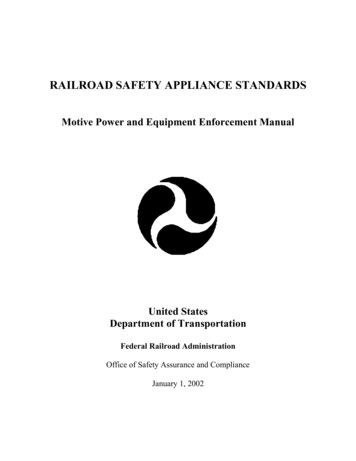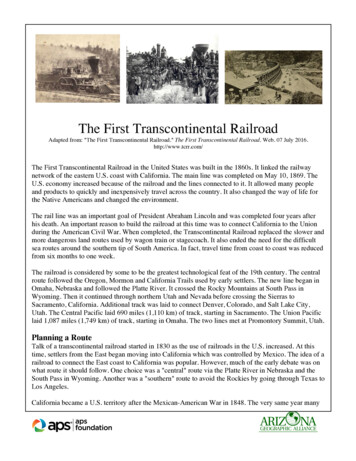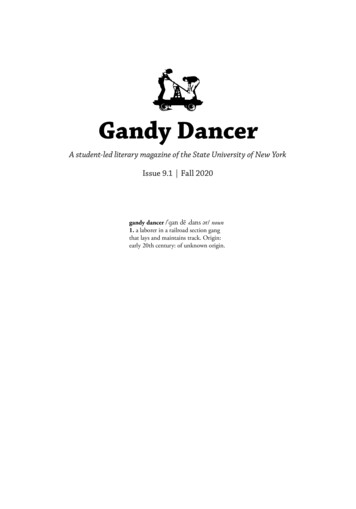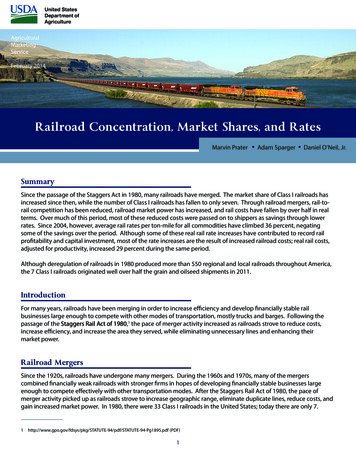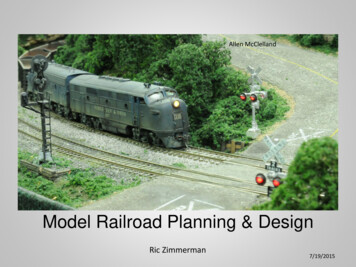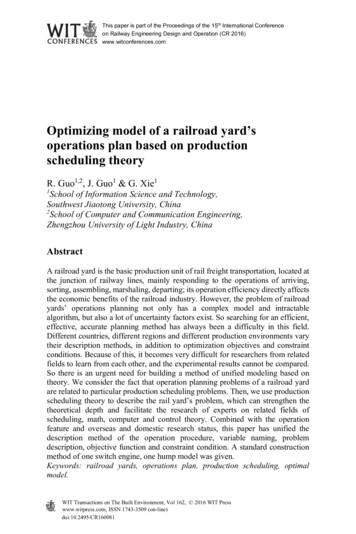
Transcription
This paper is part of the Proceedings of the 15th International Conferenceon Railway Engineering Design and Operation (CR 2016)www.witconferences.comOptimizing model of a railroad yard’soperations plan based on productionscheduling theoryR. Guo1,2, J. Guo1 & G. Xie11School of Information Science and Technology,Southwest Jiaotong University, China2School of Computer and Communication Engineering,Zhengzhou University of Light Industry, ChinaAbstractA railroad yard is the basic production unit of rail freight transportation, located atthe junction of railway lines, mainly responding to the operations of arriving,sorting, assembling, marshaling, departing; its operation efficiency directly affectsthe economic benefits of the railroad industry. However, the problem of railroadyards’ operations planning not only has a complex model and intractablealgorithm, but also a lot of uncertainty factors exist. So searching for an efficient,effective, accurate planning method has always been a difficulty in this field.Different countries, different regions and different production environments varytheir description methods, in addition to optimization objectives and constraintconditions. Because of this, it becomes very difficult for researchers from relatedfields to learn from each other, and the experimental results cannot be compared.So there is an urgent need for building a method of unified modeling based ontheory. We consider the fact that operation planning problems of a railroad yardare related to particular production scheduling problems. Then, we use productionscheduling theory to describe the rail yard’s problem, which can strengthen thetheoretical depth and facilitate the research of experts on related fields ofscheduling, math, computer and control theory. Combined with the operationfeature and overseas and domestic research status, this paper has unified thedescription method of the operation procedure, variable naming, problemdescription, objective function and constraint condition. A standard constructionmethod of one switch engine, one hump model was given.Keywords: railroad yards, operations plan, production scheduling, optimalmodel.WIT Transactions on The Built Environment, Vol 162, 2016 WIT Presswww.witpress.com, ISSN 1743-3509 (on-line)doi:10.2495/CR160081
80 Computers in Railways XV: Railway Engineering Design and Operation1 IntroductionA railroad yard, also known as a marshalling station, shunting yard or railwayyard, is the core of the railway terminal, which is the distribution place forallocating wagon-flows coming from arrival trains to form the new trains.According to statistics, in China, the annual daily number of sorted wagons of arailway network railroad yards is 6000 and the efficiency and quality directlyaffect the work efficiency and economic benefit of railway transportation [1]. Butthe planning issue of a railroad yard’s operations plan not only has complex modelbuilding, involves creating a difficult algorithm for solving it but also hasuncertainty factors. Therefore, searching for an efficient real-time planningmethod is the difficult point in the field. Different countries, station types andoperation equipment vary in their description, optimization objectives andconstraint conditions making it hard to learn from each other from relevantresearch results and to compare the experimental results. The development of thisfield is restricted and there is an urgent need to build up a set of theoretical supportfor a unified modeling method. The planning issue of a railroad yard’s operationsplan is a large-scale production scheduling problem, a kind of classical problemof combination and optimization. From the point of view of computationalcomplexity, this kind of problem has NP properties and it is hard to find theoptimal solution. The approximate solution is usually obtained by using theapproximate algorithm or the heuristic algorithm.In this paper, combined with the modeling method of production schedulingtheory, we build a wagon-flow allocation model of single directional, singlepushing and single humping. This model is established on the optimal goal for theshortest dwell time of all cars during a stage plan time and with some constraintconditions such as car flows joining relation, destinations, full axis, rail cars inarrival or departure trains, hump operation type, sorting sequence, assemblingsequence etc.2 Problem statement2.1 Production scheduling problemThe production scheduling problem [2] is one of the representative problems ofcombinatorial optimal problems in operations theory. It means making thereasonable production decision under the known condition of production tasks.According to the expended goals, it should determine how to most efficientlyallocate the limited human and material resources to different tasks in time order.If one only considers the processing sequence of the tasks, it is a sequencingproblem in mathematics, which is an urgent problem to be solved in the processof manufacturing production management [3]. In 1954, after the first article whichdescribed a permutation flow shop scheduling problem of two machines waspublished [4], in the following 60 years, scheduling problems have been theconcern of researchers in the fields of mathematics, computers, industrialengineering and economic management.WIT Transactions on The Built Environment, Vol 162, 2016 WIT Presswww.witpress.com, ISSN 1743-3509 (on-line)
Computers in Railways XV: Railway Engineering Design and Operation81According to the literature [5–9], the research can be divided into the following5 stages: for the first stage (1950s–1960s), its technical characteristics are acombination of analysis; for the second stage (1960s–1970s), the main technicalfeatures are branch and bound, and dynamic programming; for the third stage(1970s–1980s), the main technical feature is computational complexity theory; forthe fourth stage (1980s–1990s), the main technical feature is the approximationalgorithm combined with heuristic strategies; for the fifth stage (1990s to date),the main technical features are theories of real time and uncertainty modernscheduling. The research of production scheduling has been accompanied by thedevelopment of mathematics and computer science. For different productionprocesses, the mathematical models of the different production schedulingproblems vary. As an easy description, in 1967, Conway et al. [10] proposed amethod of four parameters representing a scheduling problem. Based on that, in1979, Graham et al. [11] proposed a three-parameter representation method. Thena large number of studies followed using the description of three parameters α β γ,and the definitions of Pinedo in [12] can be associated with our question asfollows.2.1.1 The possible machine environments specified in the α fieldIdentical machines in parallel (Pm): There are m identical machines inparallel.Flow shop (Fm): There are m machines in series. Each job has to beprocessed on each one of the m machines. All jobs have to follow the sameroute, i.e., they have to be processed first on machine 1, then on machine 2,and so on.Flexible flow shop (FFc): A flexible flow shop is a generalization of the flowshop and the parallel machine environments. Instead of m machines in seriesthere are c stages in series with at each stage a number of identical machinesin parallel. Each job has to be processed first at stage 1, then at stage 2, andso on. A stage functions as a bank of parallel machines; at each stage job jrequires processing on only one machine and any machine can do. Thequeues between the various stages may or may not operate according to theFirst Come First Served (FCFS) discipline. (Flexible flow shops have in theliterature at times also been referred to as hybrid flow shops and as multiprocessor flow shops.)2.1.2 The processing restrictions and constraints specified in the β fieldRelease dates (rj ): If this symbol appears in the β field, then job j cannot startits processing before its release date rj. If rj does not appear in the β field, theprocessing of job j may start at any time.Preemptions (prmp): Preemptions imply that it is not necessary to keep a jobon a machine, once started, until its completion. When preemptions areallowed prmp is included in the β field; when prmp is not included,preemptions are not allowed.Permutation (prmu): A constraint that may appear in the flow shopenvironment is that the queues in front of each machine operate according tothe First In First Out (FIFO) discipline.WIT Transactions on The Built Environment, Vol 162, 2016 WIT Presswww.witpress.com, ISSN 1743-3509 (on-line)
82 Computers in Railways XV: Railway Engineering Design and OperationBlocking (block): Blocking is a phenomenon that may occur in flow shops.If a flow shop has a limited buffer in between two successive machines, thenit may happen that when the buffer is full the upstream machine is not allowedto release a completed job.2.1.3 Possible objective functions to be minimized in the γ fieldTotal weighted completion time ( w jC j ) : The sum of the weightedcompletion times of the n jobs gives an indication of the total holding orinventory costs incurred by the schedule. The sum of the completion times isin the literature often referred to as the flow time. The total weightedcompletion time is then referred to as the weighted flow time.2.2 Technical operations of railroad yardsEach railroad yards needs to set up a number of yards according to its owntransport production demand; it can complete multi-destination technicaloperation such as train arrival and departure operations, car sorting and assemblyoperations. The function partition and flexible use of each yard are determined bythe rational layout of the station, the capacity of the technical equipment, and thecars meeting a balance between inbound and outbound trains. Based on thepractical operational process, the yards can be divided into functions of a receivingyard, a classification yard and a departure yard. In addition, there can be a humpin the linking area between the receiving yard and the classification yard, and alsothe pulling out tracks in the linking area between the classification yard and thedeparture yard. The hump has a certain degree of slope, so that it can help thewagon flow under potential energy to slip into the classification yard. Therefore itis always used for sorting. The pulling out tracks are the flat tracks used formarshalling or picking up, and also for no hump car sorting. Figure 1 gives astation chart of a bidirectional three-grade six-yard transversal type railroad yardwhich is commonly used for larger operations.Figure 1:Station chart of a bidirectional three-grade six-yard transversal typerailroad yard.WIT Transactions on The Built Environment, Vol 162, 2016 WIT Presswww.witpress.com, ISSN 1743-3509 (on-line)
Computers in Railways XV: Railway Engineering Design and Operation83Railroad yards have perfect transportation equipment in that they can carry outall of the work flow in the station such as arriving, sorting, accumulating,marshalling and departing.There are many kinds of definitions about the functional assignment in theclassification yard and receiving yard (see [13–17]). In this paper, we review oneof the situations: the arriving technical operation refers to the task of meeting thearrival train on the receiving track and of its being inspected by an inspector groupetc.; the sorting technical operation refers to disassembling the inbound train flowor train set onto the special track of the classification yard via the hump or pull outtrack according to the cars’ destinations; the accumulating technical operationrefers to the car halting process which starts from the time of humping into theclassification yard and ends at the time of pulling out to the departure yard; themarshalling technical operation refers to the shunting operation which needs toselect accumulated cars by the pulling out engine to make up wagon flowaccording to the rules of the freight train formation plan, the train diagram, and theregulations governing the railway technical operation on the pulling out tracks; thedeparture technical operation refers to the setup operation for the departing trainin the departure yard.2.3 The relationship between production scheduling and railway yardoperation schedulingThe railway yard operations problem is the need to organize a variety of productiveresources to complete the work of meeting arriving trains and making sure trainsdepart day and night according to production demand; it is a large-scale complexproduction scheduling problem. In China, the schedulers organize the productionscheduling plan in accordance with a daily shift working plan which is made firstlyby railway administration. According to the specific circumstances of the currentstation, taking 3–4 hours as a stage, they adjust the deviation in the daily shift planand gradually make detailed operation plans to achieve the production indexes.The operation scheduling can be divided into the daily shift working plan, the stageplan and the shunting operation plan. The relationships between the differentlevels of the plans are shown in Figure 2.Daily and shift traffic plans (12h)Stage plan 1(3h) Stage plan 4(3h)*Wagon-flow allocation planShunting engines using planArrival and departure tracks using planShunting operating planFigure 2:Shunting operating planShunting operating planThe different levels of the railroad yard scheduling operation plans.WIT Transactions on The Built Environment, Vol 162, 2016 WIT Presswww.witpress.com, ISSN 1743-3509 (on-line)
84 Computers in Railways XV: Railway Engineering Design and OperationThe stage plan is the core of the whole plan, which is like a connecting linkbetween the up level plan and the down level plan. Establishment of a stage planmainly includes car assignment, the humping sequence, the marshalling sequence,hump engine scheduling, pulling out engine scheduling and arrival and departuretrack occupation, through setting a wagon-flow allocation plan, a shunting engineusage plan and an arrival and departure track usage plan. The focus of the stageplan is the wagon-flow allocation plan which forms the basis for the other twoplans. The wagon-flow allocation plan not only needs to consider the requirementsof the departure trains in the current stage, but also the factors of humps, engines,and tracks comprehensively. It mainly determines the departure train: cars comingfrom which arrival trains, the detailed destinations, and the number of cars in onedestination. The destination and all car numbers must obey the regulations of theformation plan. It is not only the embodiment of coordinated operation in sortingand assembling, but also an optimal problem of reasonable selection andcollocation. The process of wagon-flow allocation can be divided into dynamicwagon-flow allocation and static wagon-flow allocation [18]. Dynamic wagonflow allocation mainly solves how to set the order of sorting based on the demandof the outbound trains. Static wagon-flow allocation studies focus on how to maketrain allocation under the condition of determined sorting order. Therefore, the keyto finding the optimum wagon-flow allocation plan is to choose a rational sortingorder. The wagon-flow allocation is discussed in the following paragraphs.The research into the railway yard operation problem involves many technicalterms, which makes it difficult to understand for experts in the field of otherscheduling problems from other majors. Therefore, we hope that this problem canbe changed from a specific scheduling problem of railway yards to a more generalproduction scheduling model. The forms of the production scheduling problem arevarious, and it is difficult to unify. In fact, many technical terms originate frommanufacturing scheduling problems which first attracted attention, such asmachine, job, operation and order. In order to unify the terms, the specificscheduling problems can be abstracted and converted into a standard form of threeparameters.Based on the description of the deterministic production scheduling problem,the model distributes receiving tracks, inspectors, humping engine, hump,classification tracks, pulling out engine and the number of departure tracks todifferent buffers, and makes an inbound train correspond to a job and technicaloperations correspond to different machines. So, the description of a wagon-flowallocation problem in a specific railway yard is as follows.The total number of inbound trains is n, where the trains have differentpriorities. The yards consist of 18 receiving tracks, 2 humping engines, 1 piece ofhump equipment, 30 classification tracks, 1 pulling out engine, 14 departuretracks, and 2 departure technical operation groups. Each inbound train needs fouroperating procedures in order: they are arriving technical operation, sortingtechnical operation, marshalling technical operation and departing technicaloperation. Each procedure can only be processed on one machine with no preempt.When the buffer is without enough spare space, the upstream machine can’t releasethe job. Each procedure needn’t meet the first in first out rule, that is to say theWIT Transactions on The Built Environment, Vol 162, 2016 WIT Presswww.witpress.com, ISSN 1743-3509 (on-line)
Computers in Railways XV: Railway Engineering Design and Operation85model has no permutation constraint. In addition, the wagon-flow allocation planshould be constrained by the requirements of the formation plan and the traindiagram; this problem also belongs to the scheduling problem and has a due date.As the stage plan is only a part of the daily shift working plan and the jobs havedifferent arrival times, the total completion time is not suitable to this problem asit can’t recognise the efficiency of inbound trains. We adopt the total wagon-flowdwell time (Cj′) on the station during a stage plan time as the optimal function.Based on the above analysis, the problem can be described as a flexible flow shopscheduling problem with blocking. The problem described by the three parametersis: FF4 rj, block w jC j . Figure 3 illustrates the job flow of the problem.Figure 3:The job flow of the wagon-flow allocation problem.3 The optimal model of the scheduling problem ofrailroad yardsThe model of single pushing and single humping is a fundamental schedulingformation in a wagon-flow allocation problem. Based on this model,many problems of other models can be transformed or expanded. Other modelingproblems refer to double pushing and double humping, the yards that receiveexchange cars, empty car distribution and multi-objective optimization. Comparedwith others, sorting is the core operation. We assume that under the condition ofsufficient operation resources, which include the group of inspectors, the tracks ofall kinds of yards, and the marshalling sequence being equal to the departuresequence according to the train diagram, the problem is simplified to a sortingsequence optimal problem. When we assume the case of one humping engine andone pulling out engine, the problem can be described as F2 rj, block w j C j in theformat of production scheduling theory.For the characteristics of the wagon-flow problem, the conventions are givenas follows: the total number of trains including which are halting in theclassification yard, having arrived or being expected to arrive in the receiving yardis n 1, we assume that all of the cars are in the classification yard at the beginningWIT Transactions on The Built Environment, Vol 162, 2016 WIT Presswww.witpress.com, ISSN 1743-3509 (on-line)
86 Computers in Railways XV: Railway Engineering Design and Operationof the stage plan at the 0th inbound train; the total number of outbound trains in thetime of a stage plan is m 1, where we assume that the (m 1)th outbound train refersto all of the cars not assembled to any outbound train at the end of the stage plan;the maximum number of sorting intervals is defined as K, where sorting intervalrefers to the time window between the beginning and the ending of a whole sortingoperating process, assuming T0 to be the starting time of a stage plan, and lettingthe stage plan operating time be 3–4 hours; outbound trains must obey the traindiagram to operate, but the outbound train is allowed to depart whilst not meetingthe constraint of full axis so as not to waste the operation curves of the traindiagram. The definition of the symbols used in the model are shown in Table 1.Table 1:SymbolDCCFBZJTDDJTQJBZQJjifkhFDjCiwjFD,jFC,iDj,f X KS,kCBZQJ,hTBZKS,hSymbol definition.Definitioninbound trainoutbound traindeparture technical operationmarshalling technical operationsorting technical operationreceiving technical operationsorting intervalmarshalling intervalinbound train numberingoutbound train numberingdestinationsorting interval numberingmarshalling interval numberingthe set of all destinations on the railroad yardsthe jth inbound trainthe ith outbound trainthe weight of Dj’ prioritythe set including all of fs in Djthe set including all of fs conforming to Ci’smarshalling demandthe set of cars in Dj on the destination of fthe number of set Xthe set of wagons coming from Dj,f andallocated to Ci on the destination of fthe number of Cfi,jdeparture time of Ciarrival time of Djdeparture operating time of Cimarshalling operating time of Cisorting operating time of Djarriving operating time of Djthe number of Ci’s full axisDj assigned to the kth soring intervalthe start time of the kth soring intervalCi assigned to the hth marshalling intervalthe start time of the hth marshalling intervalVague rangesymbolic constantsymbolic constantsymbolic constantsymbolic constantsymbolic constantsymbolic constantsymbolic constantsymbolic constantj 0,1, ,ni 1, ,m,m 1f ‘1’, ‘2’, , ‘N’k 1,2, ,Kh 1,2, ,mF {‘1’, , ‘f’, , ‘N’}Dj D0, D1, , DnCi C1, C2, ,Cm 1FD,j FFC,i FDj,f Djnonnegative integerCfi,j Dj,fnonnegative integernonnegative integernonnegative integernonnegative integernonnegative integernonnegative integernonnegative integerpositive integerDJTQJ,k { D1, , Dn }nonnegative integerCBZQJ,h {C1, C2, ,Cm}nonnegative integerWIT Transactions on The Built Environment, Vol 162, 2016 WIT Presswww.witpress.com, ISSN 1743-3509 (on-line)
Computers in Railways XV: Railway Engineering Design and OperationTable nition0-1 variables represent the cars matchingrelation between Dj and Ci according time0-1 variables represent whether the direction off conforms to Ci’ formulation rules accordingto the marshalling plan0-1 variables represent whether Dj can bedisassembled on the kth soring interval0-1 variables represent whether Ci can beassembled on the hth marshalling intervalVague rangeYTi,j 0,1Yfi,j 0,1YjJTQJ,k 0,1YiBZQJ,h 0,1The production environment, the processing restrictions and constraints, andthe optimal functions of the model can be described as follows.3.1 The production environment1 humping engine and 1 pulling out engine, so it belongs to a 2 machine flow shopproblem.3.2 The processing restrictions and constraints(1) Wagon-flow joining relation constraints: 0 TC,i tCF,i tBZ ,i tJT, j tDD, j TD, j 0, 1 i m, 0 j n ; (1)YTi,j 1 TC,i tCF,i tBZ ,i tJT, j tDD, j TD, j 0TC,i, tCF,i, tBZ,i, tJT,j, tDD,j, TD,j 0, 1 i m, 0 j n;(2)(3)xfi,j YTi,j * Dj,f , 1 i m, 0 j n, 1 f N;Equation (1) is considered for the wagon-flow joining relation between Dj andCi. If it is satisfied, YTi,j 1; otherwise YTi,j 0. Equation (2) shows that all the valuesof the time variables can’t be negative. Equation (3) means the cars of Dj can beassembled to Ci if and only if YTi,j 1.(2) Destination constraints: 0 ( f F FD, j FC,i ) (FD, j FC,i ) (FD, j FC,i ) ,Yfi,j ( f FD, j FC,i) (FD, j FC,i ) 1(4)1 i m, 0 j n, 1 f N;(5)xfi,j Yfi,j * Dj,f , 1 i m, 0 j n, 1 f N ;Equation (4) shows that Yfi,j 1 if and only if the destination f of Djs carsincluded in the Ci destination set; otherwise Yfi,j 0. Equation (5) means that thecars of Dj can be assembled to Ci if and only if Yfi,j 1.(3) The car number assembling to the outbound train constraint:nd xfj 0 f 1i, j ri, 1 i m ;(6)(4) The car number constraints between the inbound train and outbound train:m i 1 f FD, jx f i, j Df FD, jj, f , 0 j n ;WIT Transactions on The Built Environment, Vol 162, 2016 WIT Presswww.witpress.com, ISSN 1743-3509 (on-line)(7)
88 Computers in Railways XV: Railway Engineering Design and Operationn j 0 f FC,inx f i, j Dj 0 f FC,ij, f , 1 i m ;(8)Equation. (7) shows that the number of cars in Dj must be greater than or equalto all the number of cars in Ci which comes from Dj; Equation (8) means that thenumber of cars in Ci must be less than or equal to the number of cars in Dj whichsatisfies the destination requirement of Ci.(5) Hump and humping engine constraints (single pushing and single humping):if Dj can be arranged to sort on the kth sorting interval, it must meet the followingconstraints:0 DJTQJ, k D j, 1 j n, 1 k K;(9)YjJTQJ,k 1 DJTQJ, k D j n Yjj 1K Yk 1jJTQJ, k 1, 1 k K;(10)JTQJ, k 1, 1 j n ;(11)nTJTKS, k Y j JTQJ, k tJT, j TJTKS, k 1 ,1 k K-1;(12)j 1n TJTKS,1 max T0, Y j JTQJ,1 TD, j tDD, j , k 11j n j TJTKS, k 1 Y JTQJ, k 1 tJT, j, j 1 T ,1 k K max n JTKS, k Yj (Tt) kjjJTQJ,D,DD, j 1 nK;(13)*tJT,j t ;(14)xfi,j YjJTQJ,k* xfi,j, 1 j n, 1 i m ;(15) Yj 1 k 1jJTQJ, kEquation (9) shows that if Dj has been arranged to sort on the kth sortinginterval, then the value of YjJTQJ,k is equal to 1; otherwise the value of YjJTQJ,k isequal to 0. Equation (10) shows that one sorting interval only can arrange oneinbound train operation. Equation (11) shows that one inbound train only canoccupy one sorting interval. Equation (12) shows that only when the upstreaminbound train has completed its sorting operation can the current inbound trainbegin its operation by the same humping engine. Equation (13) means that onlywhen Dj’s earliest sorting time is less than or equal to TJTKS,k can Dj be arranged tothe kth sorting interval. Equation (14) means that the total inbound train sortingoperating time must be less than or equal to the stage plan time T. Equation (15)shows that the number of cars coming from the unassembled trains can’t be thesame as the number of xfi,j.(6) Pulling out engine constraints:0 CBZQJ, h Ci1 h, i m ;(16)YiBZQJ,h 1 CBZQJ, h Ci WIT Transactions on The Built Environment, Vol 162, 2016 WIT Presswww.witpress.com, ISSN 1743-3509 (on-line)
Computers in Railways XV: Railway Engineering Design and Operationm Yii 1m YBZQJ, hih 189 1, 1 h m ;(17) 1, 1 i m;(18)BZQJ, hTBZKS, h tBZ,i TBZKS, h 1 ,1 i m, 1 h m-1 ;(19)TBZKS,h TC,i-tCF,i-tBZ,i, 1 h, i m ;(20)mm Yii 1 h 1BZQJ, h*tBZ,i t ;xfi,j YiBZQJ,h* xfi,j,1 j n, 1 i m ;(21)(22)Equation (16) shows that if Ci has been arranged to assemble on the hthmarshalling interval, then the value of YiBZQJ,h is equal to 1; otherwise the value ofYiBZQJ,h is equal to 0. Equation (17) shows that one marshalling interval only canarrange one outbound train operation. Equation (18) shows that one outbound trainonly can occupy one marshalling interval. Equation (19) shows that only whenthe upstream outbound train has completed its marshalling operation can thecurrent outbound train begin its operation by the same pulling out engine. Equation(20) means that only when Ci’s latest marshalling time is greater than or equal toTBZKS,h can Ci be arranged to the hth marshalling interval. Equation (21) meansthat the total outbound train marshalling operating time must be less than or equalto the stage plan time T. Equation (22) shows that if Ci hasn’t accessed anymarshalling interval, then the number of cars in the classification yard can’t be thesame as the number of xfi,j.3.3 The optimal functionsLet xfi,j be the decision variable, making the weighted total wagon-flow dwell timeon the station during the stage plan time be the optimal function, as follows:m 1 nmin z(xfi,j) i 1 j 0 f FC ,i FD , j4w j x f i, j (TC,i TD,j).(23)ConclusionsThe railroad yard scheduling problem is more complicated than the same type ofproduction scheduling problem. In any scheduling table, there is another NPproblem which refers to the resource matching problem. Combined with differentproblems, using the historical data to generate the heuristic rules, the key point forfurther research is to build up a concise model and find an efficient algorithm.AcknowledgementsThis research has been supported in part by major research projects of the ChinaRailway Corporation (2014X008-A), key projects of the research project of theChina Railway Corporation (2015X007-J) and the Educational Committee ofHenan Province of China (15A520004).WIT Transactions on The Built Environment, Vol 162, 2016 WIT Presswww.witpress.com, ISSN 1743-3509 (on-line)
90 Computers in Railways XV: Railway Engineering Design and [11][12][13][14][15][16][17][18]Jianye Song, Jinbao Xie. Basis on organization of train operation.Beijing: China Railway Publishing House, 2005.Wanliang Wang, Qidi Wu. Intelligent algorithm and application forproduction scheduling. Beijing: Science Press, 2007.Guochun Tang. Review of basic concepts of scheduling theory. Journal ofChongqing Normal University, 2012, 29(4): 1–11.Johnson S. M. Optimal two- and three-stage production schedules with setuptimes included, Naval Research Logistics Quarterly, 1954, 1(1): 61–68.Stephen C. Graves. A review of production scheduling. OperationsResearch, 1981, 29(4): 646–675.A.S. Jain, S. Meeran. Deterministic job-shop scheduling: past, present andfu
A railroad yard, also known as a marshalling station, shunting yard or railway yard, is the core of the railway terminal, which is the distribution place for allocating wagon-flows coming from arrival trains to form the new trains. According to statistics, in China, the annual daily number of sorted wagons of a
